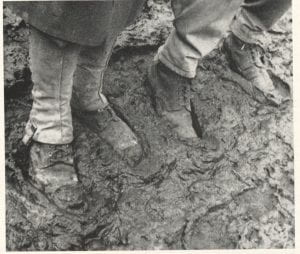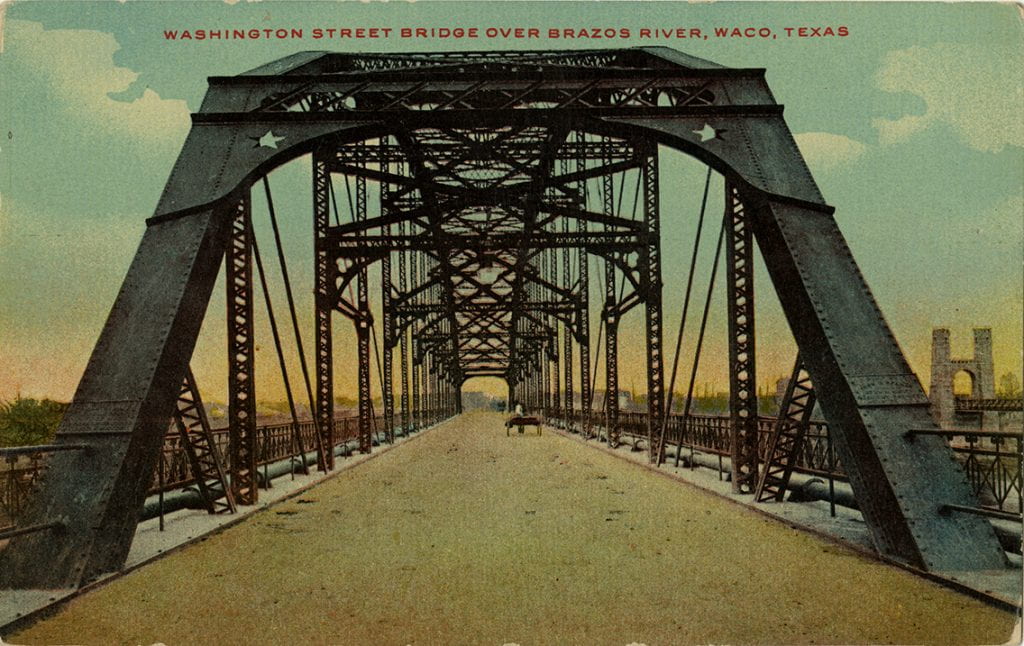Written by Sylvia Hernandez, Archivist, The Texas Collection

In 1921, 7,000 lives were lost to grade crossing accidents nationally1. Obviously, this was a problem. By July 1922 the American Railway Association introduced the Careful Crossing Campaign to highlight the high number of fatalities. Newspapers mentioned safety mechanism implementations at crossings in hopes to make drivers slow down3. The Texas Highway Bulletin also noted that the only safe grade crossing was the one that had been eliminated4. Eventually, legislation to reduce or eliminate grade crossings was introduced at the state level in December 19225. It was not passed.
That same year, the Railroad Commission acknowledged the issue but cited that since there were no laws dictating who must bear the cost of replacing the passes or to give them the right to judge a passing as dangerous, then it was not necessarily their responsibility. The commission did however state that they would join the highway commission to appeal to the legislature and abide by the state law6. Legislation for the Railroad Commission granting safety authority over crossings and eliminations was presented in 1923. It included expenses would be the responsibility of the state, county, and rail commission7.
As Passenger rail travel began to decline many smaller lines began to feel the financial strain of supplementing grade crossing elimination. The states of Texas and Ohio were able to acquire portions of the funding needed from the railroads to supplement state and federal allocations. Both states were early to realize the support.
 In 1927, after the Baylor accident, Texas Legislators Ray Stout of Ennis and Roscoe Munge of Mason wrote a bill to eliminate grade crossings. It was not passed by Governor Dan Moody. The dangerous Mays Street crossing was not addressed until 1935 when the first state railroad overpass was finally built in Round Rock8. Finally, the state highway commission called on the railroads to meet and discuss eliminating grade-level crossings in response to the emergency federal highway construction program9. Progress.
In 1927, after the Baylor accident, Texas Legislators Ray Stout of Ennis and Roscoe Munge of Mason wrote a bill to eliminate grade crossings. It was not passed by Governor Dan Moody. The dangerous Mays Street crossing was not addressed until 1935 when the first state railroad overpass was finally built in Round Rock8. Finally, the state highway commission called on the railroads to meet and discuss eliminating grade-level crossings in response to the emergency federal highway construction program9. Progress.
President Roosevelt began adding grade crossing elimination to the works relief job efforts in 1935, during the Great Depression. He designated $200,000,000 for 3,500,000 men to be allocated by November 1. By October 22, only $2,000,000 was allocated. Turns out, a clause was inserted into the federal legislation stating rail companies were not responsible for any cost of the crossing elimination10. Because of this, individual states and the federal government were the only responsible parties; the states were only bound to supply the land. Except for Texas and Ohio, many state projects stalled. Texas was awarded $23,000,000 for Highway work, $10,855,982 specifically for grade crossing elimination11.
Over time, safety measures such as over and under passes, and lighting systems have been implemented at many crossings in Texas and throughout the country. In 2017, the Mays Street Bridge in Round Rock was refurbished with a $100, 000 donation from the Union Pacific Rail Road. The city of Round Rock renamed it “The Immortal Ten” bridge which is now adorned with green lamp posts and plaques12 to honor the lives and impact of the young men who perished there ninety-five years ago.
Today, as we remember our Immortal Ten, let us also remember the others who lost their lives in similar fashion as well as the traveling party we send out this weekend.
Sources
[1] [5] [6]“Eliminating Road Crossings is Plan.” Wise County Messenger (Decatur, TX), Dec. 15, 1922.
[2] “C.C.C.–What Does it Mean!” Lubbock Avalanche (Lubbock, TX), Jul. 14, 1922.
[3] “Grade-Crossing Plans Make Driver Slow Up.” Austin American (Austin TX), Aug. 6, 1922.
[4] “Spark Plugs.” Austin American Statesman (Austin, TX), Nov. 12, 1922.
[7]“Five Items Highway Legislation Be Asked Of Special Session. The Eagle (Bryan, TX), Apr. 17, 1923.
[8] Danner, Megan, “The Immortal Ten,” Waco History, accessed January 20, 2022, https://wacohistory.org/items/show/103.
[9] “Call Rail Engineers to Study Eliminating of Grade Crossings.” Longview News-Journal (Longview, TX), Jul. 24, 1935.
[10] Pearson, Drew and Robert S. Allen. “The Daily Washington Merry-Go-Round.” Waco News-Tribune (Waco, TX), Oct. 22, 1935.
[11] “Texas Gets Nearly $23,000,000 Funds for Highway Work.” Corsicana Daily Sun (Corsicana TX), Jun. 5, 1935.
[12] “City of Round Rock Honors Baylor’s Immortal Ten.” Baylor University. Baylor magazine, Spring 2017. https://www.baylor.edu/alumni/magazine/1503/index.php?id=941100








































